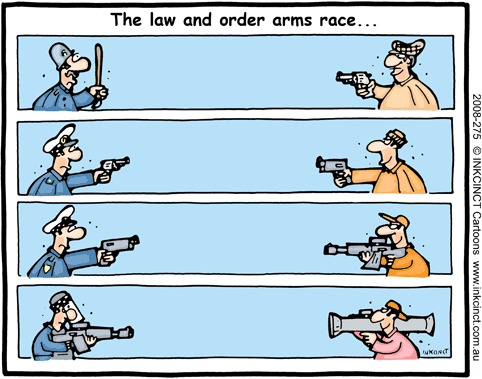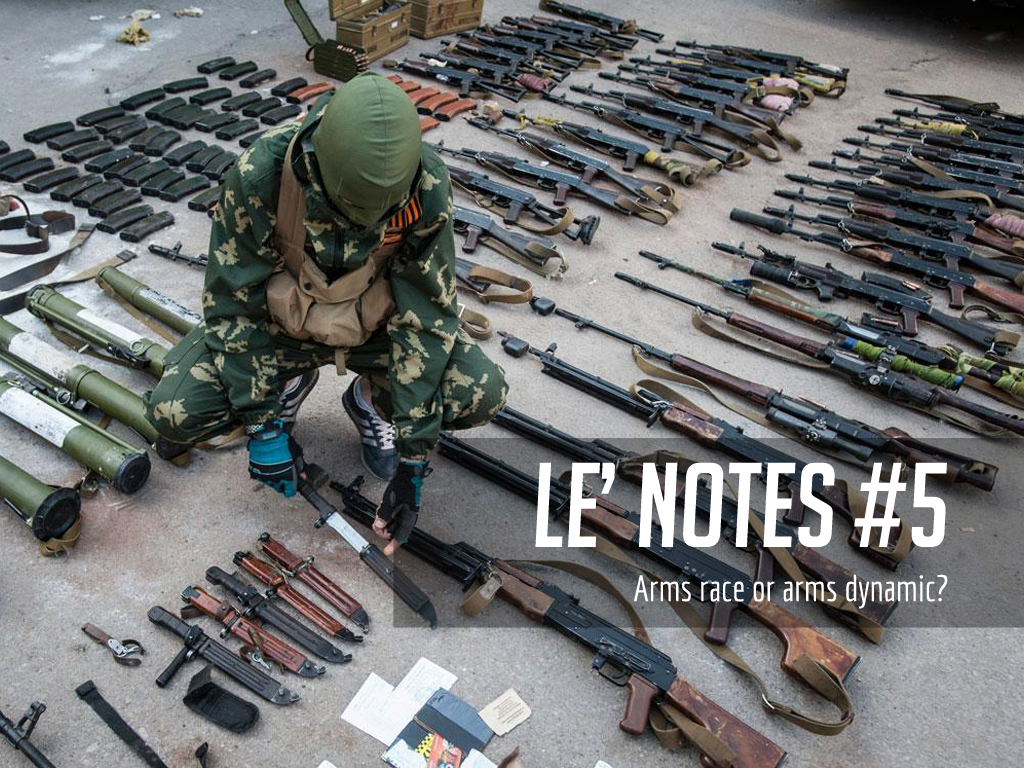This post discusses the arms dynamic and how it works.
What’s the first thing that comes to mind when you hear the term “arms race”? Does it invoke images of USA and USSR outbuilding one another in terms of nuclear weapons? Is the act of buying more guns and equipment for the military considered an arms race that is always destabilizing? Or are the headlines in the media just sensationalist bullshit?
Strap yourself, we’re going for a ride up the spiral of arms dynamic.
“What is an arms race?” is the first question that we should answer. To be frank, the term “arms race” is one of those terms that people use all the time, but don’t really understand. It is almost a blanket term for any kind of action-reaction cycle; I get new guns, you get new guns. We’re automatically in an arms race. But is that always the case?

Buzan and Herring [Google Books] complain about the lack of rigid definition as to what an arms race. The metaphor of a race implies that there are at least 2 participants and both of them want to outrace one another to win. But, it then becomes easy to confuse simple military modernization or upgrading with an arms race. Also, there are very few examples of real arms races in history.
So what constitutes as an arms race? Hammond [HTML] in his book, Plowshares into Swords, lays out eight criteria of an arms race. All 8 boxes must be ticked in order for the event to be called an arms race:
- Essentially bilateral
- Specific designation of an adversary
- Military/diplomatic planning geared specifically towards countering the intent and capability of the other
- High degree of public animosity/antagonism towards the other
- Political-military linkage of state action between or among the rival force structures and strategy
- Extraordinary increases in defense spending in a short amount of time
- Focus on particular weapons system/armaments based on countering the strategy of the other
- Seeks dominance of the other
When Hammond’s strict criteria are applied, there is only one major event in history that can be classified as an arms race, which is the Anglo-German arms race that led up to World War I.
Then what’s the use of the term “arms race” if no single event can be considered an arms race? Gray
Here’s where Buzan and Herring’s model of the arms dynamic comes in handy. The Buzan-Herring arms dynamic model starts from the middle, or the maintenance of the status quo. At this point, states conduct business-as-usual; maintaining weapons just to preserve the balance as it is. But one day, when the need arises, the state may conduct an arms buildup. The reasons for this buildup are many; we’ll get to that later. When arms buildup reaches a ‘critical mass’, it may become an arms race, so long as it satisfies Hammond’s long 8-point list. On the other side of the spectrum, sometimes states feel they need to downsize, so an arms build-down occurs.
So, instead of dichotomous labeling system, Buzan and Herring thought the concept would be better if it was put on a spectrum. Then again, it also raises some problems. How would we know precisely if a state is initiating an arms buildup or are simply maintaining the status quo?
The short answer is, we may never know. Remember, in this anarchic world, there is no rule that says you have to clearly state your intentions or even plans to other people. There are a number of pitfalls that one needs to avoid when analyzing an arms dynamic. The first rule is to make sure that an arms build-up doesn’t automatically imply an imminent arms race. Just because a state is acquiring arms does not mean they are engaging someone in arms race. The export/import of arms is a good business; some states make a living off that. Some states just have the money to supply their militaries with shiny new toys every Christmas. Some states have a massive arms industry that churns out tons of weapons every year. Supply and demand! It is also important to pay equal attention to the intentions of states purchasing arms. Although there may never be a clear declaration of intent, we can at least infer from existing White Papers or other defense documents a degree of truth.
Why do arms dynamics happen?
Short answer: internal and external factors that feed an action-reaction cycle.
The classic explanation for an arms dynamic (or race) is the action-reaction cycle (See Herz [paywall]). Put simply, it’s a tit-for-tat exchange. I buy a new tank, you buy anti-tank missiles. I buy nuclear missiles, you buy some too. See where we’re going? The culmination of this tit-for-tat exchange (often described as a “spiral model”) is the tipping point, where both parties essentially decide to launch a preemptive/preventive war against one another to halt the spiral completely and establish dominance.
This model does little to explain arms dynamics, short of a grim cycle that never ends. Most importantly, the action-reaction model only shows the external factors that influences an arms dynamic. Buzan and Herring then propose the “domestic structures” model that provides more depth to the classical model. Buzan and Herring’s additional dimension to the model includes a number of domestic factors that play a role in the arms dynamic:
- Institutionalization of military R&D
- Institutionalization of military production
- Economic management
- Electoral politics
- Military-industrial complex (MIC)
- Organizational politics
- Unifying and identity-creating role of threats
- Internal repression and civil war
To summarize the interconnectedness of these 8 factors at the risk of oversimplifying everything:
- Military R&D is essential in keeping up with new military technology. However, too much R&D may trigger an arms buildup.
- Military production is related to the military-industrial complex. Production will intensify if the state is in a long-standing rivalry against another. To stay alive, these two factors will either expand to become economies of scale or just big enough to supply the demands of your own troops.
- Electoral politics often determines the other factors. If Trump becomes president, he’ll surely force the military-industrial complex to into overdrive because America faces a threat from Canada. Or just because he has friends in the MIC that can benefit from the existence of a threat.
- Which brings me to factor (7). 9/11 solidified the American will to fight back against the angry Arabs, which in turn ramped up production and R&D.
Going off track a bit since we’re talking about military production and R&D, what’s the advantages of buying arms and aiming for self-sufficiency?
For arms purchase, you benefit from lower prices due to economies of scale. Which is why terrorists just love their AKs. Also, you gain access to an array of arms that are already proven, so you know you won’t get any crap. However, there’s always the issue of compatibility. In the 1960s, Indonesia bought several Whiskey-class submarines from Russia. Sadly, the subs were abandoned because they weren’t built to function in Indonesia’s hot tropical waters. You need to remember that those arms were built to suit the operational and tactical needs of the exporter; not necessarily yours. And since you’re buying, you are always at the whim of the suppliers.
For arms self-sufficiency, there’s the benefit of not having to be at the whim of the market. You also have the freedom to make weapons as you wish, depending on your needs, like the Singapore military-industrial complex. However, you might not be able to leverage on economies of scale because you’re only building for your own supply, which might not always be huge enough to create economies of scale. Also, there’s the issue of cost. It’s not easy to build a military-industrial complex from scratch. Imagine the technology, human resources, natural resources, and the cost of the trial-and-error! Since you’re small, you will also suffer a credibility disadvantage. Like, when given a choice between an unproven burger joint vs McDonalds, 9 out of 10 people will go to McDonalds.
The bells ring…
To summarize quickly since I’m hungry as hell:
- An arms race is a part of the arms dynamic, which is a spectrum of possible scenarios involving two parties (not necessarily states) in terms of building means to hurt one another.
- An arms dynamic happens due to external factors (action-reaction cycle) and may be enhanced by internal factors (domestic structures).
- It is important to distinguish between acquisition and intent. Acquisition of arms does not always translate to potential arms racing; maybe the party has a different intent.
- There are benefits and also disadvantages to both purchasing arms over the counter at your local arms dealer and making them yourself.
Featured picture credit: Armament Research (ARES)
